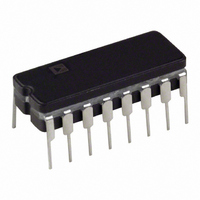AD688BQ Analog Devices Inc, AD688BQ Datasheet - Page 12

AD688BQ
Manufacturer Part Number
AD688BQ
Description
IC VREF HIGH PREC +/-10V 16-CDIP
Manufacturer
Analog Devices Inc
Datasheet
1.AD688AQ.pdf
(16 pages)
Specifications of AD688BQ
Temperature Coefficient
3ppm/°C
Rohs Status
RoHS non-compliant
Reference Type
Series
Voltage - Output
±10V
Tolerance
±2mV
Number Of Channels
2
Current - Quiescent
12mA
Current - Output
10mA
Operating Temperature
-40°C ~ 85°C
Mounting Type
Through Hole
Package / Case
16-CDIP (0.300", 7.62mm)
Topology
Series
Input Voltage
12V To 36V
Reference Voltage
10V
Reference Voltage Tolerance
2mV
Voltage Reference Case Style
DIP
No. Of Pins
16
Voltage - Input
-
Current - Cathode
-
Lead Free Status / RoHS Status
Contains lead / RoHS non-compliant
Available stocks
Company
Part Number
Manufacturer
Quantity
Price
Part Number:
AD688BQ
Manufacturer:
ADI/亚德诺
Quantity:
20 000
AD688
Attempts to drive a large capacitive load (in excess of 1000 pF)
may result in ringing or oscillation, as shown in the step
response photo (Figure 29). This is due to the additional pole
formed by the load capacitance and the output impedance of
the amplifier, which consumes phase margin. The recom-
mended method of driving capacitive loads of this magnitude is
shown in Figure 30. The 150 Ω resistor isolates the capacitive
load from the output stage, while the 10 kΩ resistor provides a
dc feedback path and preserves the output accuracy. The 1 µF
capacitor provides a high frequency feedback loop. The
performance of this circuit is shown in Figure 31.
V
V
OUT
OUT
V
V
IN
L
Figure 29. Output Amplifier Step Response, C
100
90
10
0%
100
90
10
0%
+
–
10V
Figure 30. Compensation for Capacitive Loads
1mV
+
–
10V
V
Figure 27. Load Crosstalk Test Circuit
IN
A4
Figure 28. Load Crosstalk
10k Ω
1V
1 µ F
5V
V
OUT
150 Ω
V
L
1kΩ
10V
0V
C
1 µ F
200µs
L
A3
V
OUT
10V
L
2µs
= 1 µF
+
–
Rev. B | Page 12 of 16
BRIDGE DRIVER CIRCUIT
The Wheatstone bridge is a common transducer. In its simplest
form, a bridge consists of four 2-terminal elements connected to
form a quadrilateral, a source of excitation connected along one
of the diagonals and a detector comprising the other diagonal.
In this unipolar drive configuration, the output voltage of the
bridge is riding on a common-mode voltage signal equal to
approximately V
necessarily be limited to high common-mode rejection
techniques such as instrumentation or isolation amplifiers.
However, if the bridge is driven from a pair of bipolar supplies,
then the common-mode voltage is ideally eliminated and the
restrictions on any processing elements that follow are relaxed.
As shown in Figure 32, the AD688 is an excellent choice for the
control element in a bipolar bridge driver scheme. Transistors
Q1 and Q2 serve as series pass elements to boost the current
drive capability to the 57 mA required by the typical 350 Ω
bridge. A differential gain stage may still be required if the
bridge balance is not perfect.
Figure 31. Output Amplifier Step Response Using Figure 30 Compensation
5
R3
V
OUT
V
IN
R
B
R2
9
100
90
10
0%
A2
7
10V
10
A1
IN
R1
/2. Further processing of this signal may
Figure 32. Bipolar Bridge Drive
6
8
1V
R4
R5
12
AD688
4
R6
11
3
13
A3
A4
200µs
14
15
16
1
2
–V
+V
S
S
220Ω
220Ω
–15V
–
+15V
E
O
+
Q
2N3904
Q
2N3906
1
2
=
=









